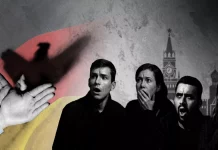
By Donald N. Jensen, for CEPA
For all the impressive research on Russian information operations in recent years—we have excellent studies of Kremlin troll farms, and how Russia disseminates its narratives on mainstream and social media—surprisingly little work has been done on how the bureaucratic machinery of Kremlin information operations actually works. Do its activities proceed from a grand strategy or are they opportunistic? Is there an interagency process for formulating strategy toward a specific country? How does the government apparatus adapt to change? Above all, how much do Russian President Vladimir Putin, or the people immediately around him, control how these operations are conducted? These questions are of more than academic interest, since their answers provide clues to the Kremlin’s points of vulnerability as the West devises polices to push back.
Mark Galeotti’s recent study of Russian influence operations is an excellent start in addressing this challenge. Putin is by no means in charge of everything, he concludes. Galeotti says Russia’s active measures campaigns are characterized by bottom-up initiatives from a variety of actors. But they are also driven by the broad guidance and encouragement of the Kremlin, and the hope of political and economic rewards if successful. Many of these initiatives come to nothing, or are simply part of the diffuse, low-level “static” with which the Russians try to jam Western public and political discourse. They may be counterproductive or even derive from misunderstandings of the Kremlin’s interests—although, even then, they will typically at least have the secondary benefit of cluttering and confusing the information space.
Among Galeotti’s other findings:
- Russia carries out and encourages “active measures” in Europe to destabilize and confuse governments and societies. But these efforts are often opportunistic and shaped by local conditions. There is no grand strategy beyond weakening the EU and NATO, and creating a more conducive environment for itself.
- The Kremlin’s initiatives involve a wide range of actors, from officials and the media, through military threats, to business lobbies and the security services. Russia pursues different priorities in different countries, depending on the correlation between the strength of countries’ national institutions and their vulnerability to Russian influence.
- Nonetheless, the Kremlin strives to coordinate certain operations across platforms. If there is a command-and-control node, it is within the Presidential Administration—perhaps the most important single organ within Russia’s highly de-institutionalized state.
A crucial subset of Russia’s active measures is its information war capability, especially its ability to influence media narratives in target countries. That said, Galeotti argues, the role of information operations is often misunderstood and overstated, perhaps precisely because it is by definition public, and also because it is easy to assume causation where one might not exist. It is not, he states, as though Russian propaganda made every Euroskeptic or even NATO-skeptic that way. Even so, disinformation—the spread of often false or distorted news—and a deluge of alternative opinions meant to drown out the realities are undoubtedly central elements of Moscow’s information operations. In part, this is the realm of foreign-language media such as RT and the Sputnik online news agency (in 30 languages). Russian-language television is widely available outside the country, and a plethora of newspapers and sites exist online.
Without giving up hope of persuading Moscow to change its policies, Galeotti suggests, Europe must nonetheless address its own vulnerabilities, “fixing the roof” rather than simply hoping the rain will stop. Among other things, he says, this includes addressing democratic backsliding in parts of the continent. His recommendations:
Comprehend the challenge: Broaden European understanding of security in this hybrid war and invest more in effective analysis and intelligence on the ground. Watch the Kremlin’s Presidential Administration in particular, and identify individual curators and their methods.
Contain the chaos: Address the counterintelligence gap by agreeing to a minimum level of spending for EU member states. Seal chinks in the EU’s armor by educating national populations to be more critical of disinformation, and by countering democratic backsliding in certain member states.
Deter diffuse threats: Make consistent but asymmetric responses to Russian active measures; any arm of the Russian state is fair game. Name and shame individuals behind active measures and designate Russian organizations acting with hostile intent as “foreign agents.”
By Donald N. Jensen, for CEPA
Donald N. Jensen is a Senior Adjunct Fellow at the Center for European Policy Analysis where he edits the StratCom weekly Editor’s Note. Jensen is also a Senior Fellow at the Center for Transatlantic Relations, Johns Hopkins School of Advanced International Studies. A former U.S. diplomat, he writes extensively on Russian foreign and domestic politics, especially Russia’s relations with Europe.





